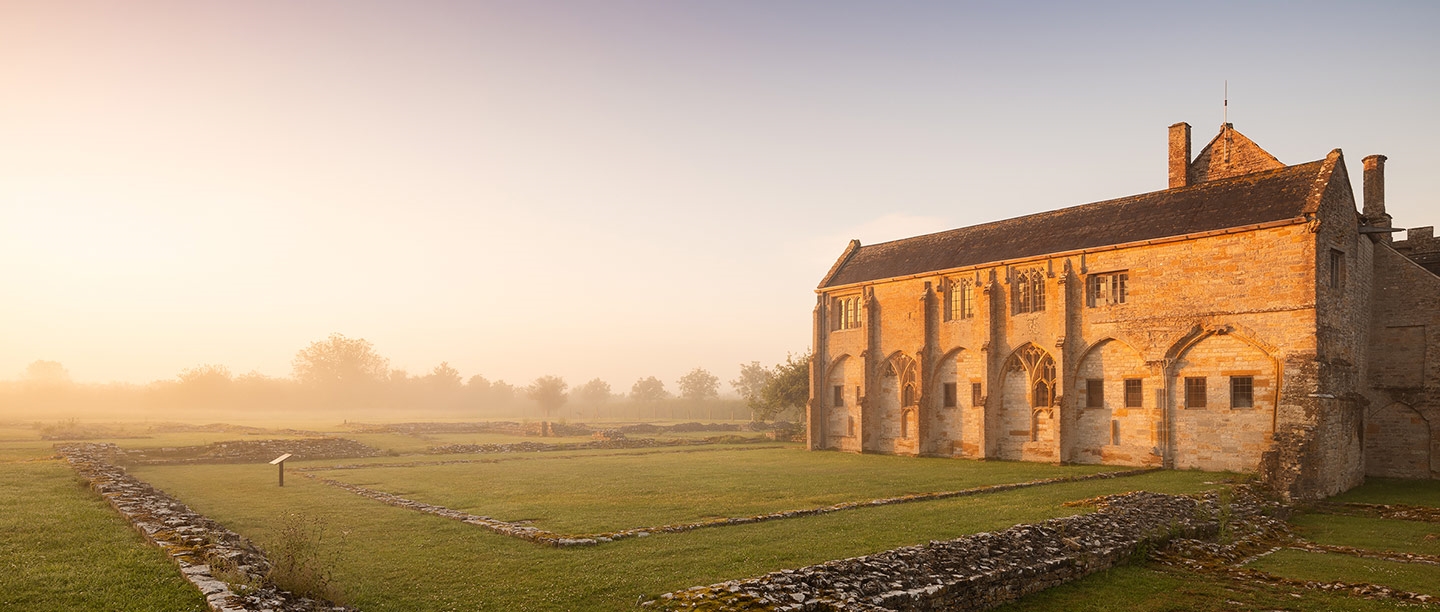The Anglo-Saxon abbey
Standing on a low hill in the marshy expanse of the Somerset Levels, Muchelney has been a site of human occupation since at least the Roman period. Monks first arrived at this secluded place in about 700.
The monastery’s founder was King Ine of Wessex (reigned 689–726). At the time of his accession, his kingdom dominated much of southern England. Little is known about this monastery other than the names of some of its abbots and monks, but it would have been a centre for spreading the Christian message as well as a place of prayer for the monks. The abbey was established at a time when the people of Anglo-Saxon England were converting to Christianity.
This first phase of monastic life at Muchelney ended in the 9th century. The abbey’s destruction or abandonment was probably at the hands of the Danes, or Vikings, whose armies penetrated deep into Wessex. However, monastic life was subsequently revived at the abbey in the 10th century. A charter states that it was refounded by King Athelstan in 939.
The remains of the small stone Anglo-Saxon church at the abbey probably date from the 10th century. It was also around this time that the monks adopted the Rule of St Benedict, a demanding set of instructions concerning every aspect of monastic life. It also specified that the monks should set aside time each day for communal prayer, reading and manual labour.
A charter dated to 995 refers to Muchelney as a ‘little monastery’, and it was still a small foundation at the time of the Norman Conquest. In 1086 the Domesday Book recorded that the abbey had a modest income of £3 a year. Most of its estates were clustered near the monastery, and it also had a vineyard and fisheries that produced 6,000 eels a year. Eels were important to the monks’ diet and economy – as well as being eaten, sold and exchanged for other goods, they were also put to medicinal uses.
An uneven history
The 12th century witnessed the ambitious rebuilding of the abbey’s church and the main structures around the cloister. Work on the east end of the church must have been completed by 1200, when a charter confirming a gift to the monastery was sealed on the high altar.
Many local landowners gave generously to the monastery. Some made gifts for specific purposes such as the repair of books, the burning of lamps and candles before altars in the church, charity for the poor, and special allowances (called pittances) of wine, spices and food for the monks on important holy days.
Nonetheless, the abbey’s history was uneven and there is evidence of financial hardship at times. In 1239, Bishop Jocelin of Bath and Wells granted Muchelney permission to derive additional income from parish churches in its possession so that it could increase its provision of charity and hospitality – key monastic obligations.
Four years later, the abbey was described as ‘distressed by water’, indicating the flooding of its buildings or estates. The Somerset Levels were even more vulnerable to flooding in the Middle Ages than today. William Malmesbury, the 12th-century monastic author, remarked on the abbey’s location that ‘in summer it may be reached by foot or, more often, by horse, but in winter never’.
Nevertheless, thanks to gifts from its benefactors, the abbey had sufficient resources to undertake extensive building works in the mid 13th century. A gift in 1266 paid for roofs for the chapter house, cloister, dormitory and refectory.
As well as being a place of prayer, the abbey was also called upon to provide services for the state. This included accommodation for former royal servants. Among them were John la Foullere, probably a retired court jester, and John Trentham, who had been the king’s harp player.
The records of visitations – formal investigations into monastic life – conducted by the Bishop of Bath and Wells provide valuable insights into life at the abbey and the conduct of its monks. In 1335 Bishop Ralph of Shrewsbury ordered the repair of the church and criticised the monks for leaving the cloister without permission. They were also reprimanded for the elaborate canopies installed above their beds in the communal dormitory.
Shortly afterwards the abbey would have been badly affected by the Black Death. Abbot John Codeworth, who died in 1349, was probably among its victims. Mortality caused by the plague was doubtless on the mind of Abbot Thomas Overton when in 1354 the pope gave him permission to appoint a confessor able to grant full remission of his sins at the hour of his death.
There may have been as many as 50 monks at Muchelney at the turn of the 14th century. In 1381, this number had been reduced to 17.
A final flowering
Visitations, as was their nature, continued to find fault. In 1455, for example, Brother John Longport was singled out for criticism by Bishop Thomas Beckington for his gluttony, drunkenness and swearing. But more positive evidence shows that several Muchelney monks were graduates of Oxford University. Moreover, local people continued to turn to the monastery for prayers, and in 1449 the Bishop of Bath and Wells praised the abbot and prior for their ‘great knowledge of letters’.
There were major building works at the monastery in the late 15th century. The church was renovated, the abbot’s house enlarged and the cloister walkways were rebuilt on a magnificent scale, with elaborate stone vaulted ceilings. The dignified celebration of the liturgy also remained a priority. In about 1520 the abbey engaged the services of one Ralph Drake to play the organ and to instruct a monk and four choirboys in music – probably the singing of elaborate multi-part polyphony.
A reconstruction of Muchelney Abbey as it may have looked in about 1500. When complete, the church (right) would have dwarfed the adjacent parish church, which was rebuilt in the 15th century
© Historic England/English Heritage Trust (illustration by Luis Taklim, Anyforms Design)
The end of monastic life
Muchelney was soon caught up in the religious changes that swept through England during the reign of Henry VIII. In 1532, the king and Thomas Cromwell, his arch fixer, forced Abbot John Sherborne to resign.
His replacement was a junior monk called Thomas Inde. Unqualified for the role, Inde rapidly plunged the monastery into debt, pawning the abbey’s silver at Exeter – probably to repay the bribes to Cromwell and his henchmen that had smoothed his appointment.
The abbey’s end came on 3 January 1538 when Inde and the remaining ten monks surrendered their monastery to the king’s commissioners.
Find out more about the Dissolution of the MonasteriesPost-medieval Muchelney
The abbey’s estates and buildings were granted to Edward Seymour (d.1552), the king’s brother-in-law. He rapidly demolished the church and many of the abbey’s other buildings. However, the abbot’s lodging was converted into a manor house and survived. In 1547 it was described as consisting of ‘three roofs, namely a hall, kitchen, larder house and buttery, with a chamber over the hall and beyond and by the sides thereof three other chambers’.
Seymour never lived at Muchelney and the house was let to a series of tenants. By the mid 17th century it had become a farmhouse, a fall in status which undoubtedly ensured that its medieval interiors survived.
By the 19th century, the house was appreciated for its picturesque qualities and the history of the abbey was attracting the attention of antiquarians. Archaeological exploration of the site started in 1872 and within a few years the ground plan of the church and main buildings around the cloister had been revealed.
Later history
The abbey, then still the centre of a working farm, was the subject of an article in Country Life in April 1912. Twelve years later it took centre stage during a two-day pageant, when key moments in the monastery’s history were imaginatively recreated.
The architectural and historical importance of Muchelney was such that in 1927 it was taken into State care. Excavations conducted between 1948 and 1952 uncovered the remains of the Anglo-Saxon church, a discovery reported with some excitement in the national press.
Now cared for by English Heritage, the abbey also plays a role in the country’s democratic process: the abbot’s lodging has the distinction of being the oldest building used as a polling station for national and local elections.
Find out more
-
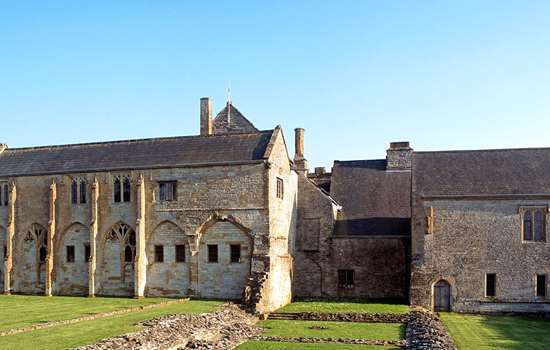
Visit Muchelney Abbey
Once a wealthy Benedictine house, Muchelney’s main buildings were demolished by Henry VIII in 1538. See the richly decorated cloister walk and thatched monks’ lavatory – the only one in Britain.
-
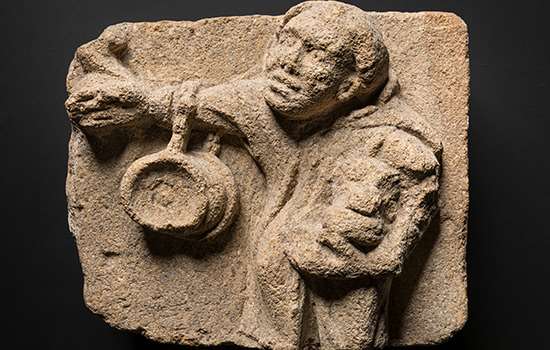
Muchelney Abbey Collection Highlights
Fragments of sculpture and everyday objects offer an insight into the lives of the abbots and monks of Muchelney, as well as the appearance of the lost monastic buildings.
-
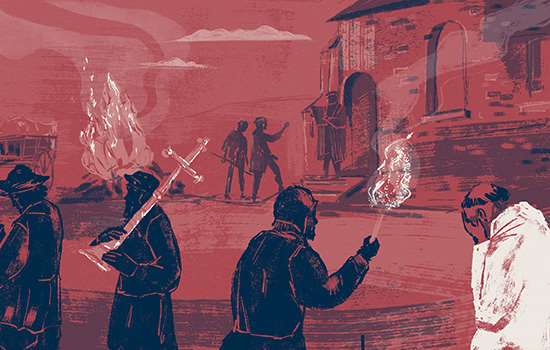
WHAT BECAME OF THE MONKS AND NUNS AT THE DISSOLUTION?
Discover what happened to the many thousands of monks and nuns whose lives were changed forever when, on the orders of Henry VIII, every abbey and priory in England was closed.
-
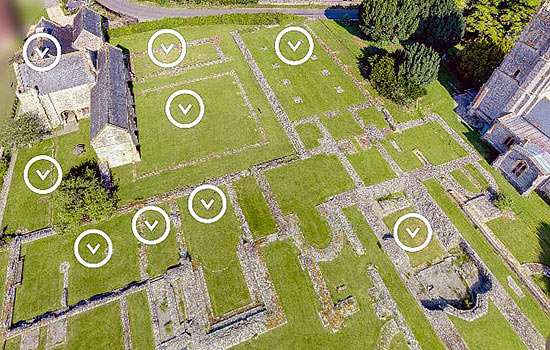
Virtual tour of Muchelney Abbey
Use this virtual tour to explore the buildings of Muchelney Abbey and discover what they reveal about the lives of the monks.
-
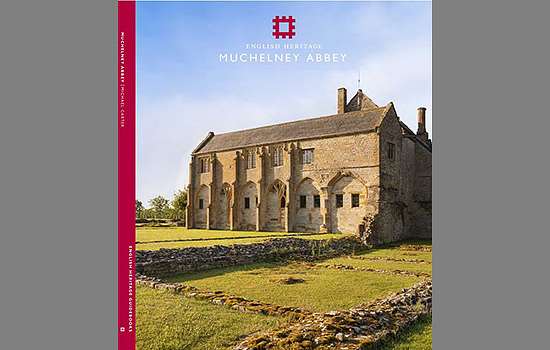
Buy the guidebook
This guidebook brings the site to life with spectacular photographs, reconstructions, historical images, maps and plans.
-

MORE HISTORIES
Delve into our history pages to discover more about our sites, how they have changed over time, and who made them what they are today.

